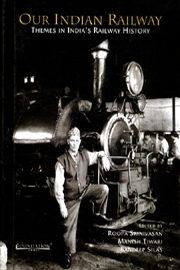Book contents
- Frontmatter
- Contents
- Foreword
- Preface
- Introduction
- 1 The Colonial Context of the Bengal Renaissance: A Note on Early Railway–Thinking in Bengal
- 2 Minute by Dalhousie on Introduction of Railways in India, as Submitted to the Court of Directors, 4 July 1850
- 3 Ackworth Committee Report
- 4 Competition and Adaptation: The Operation of Railways in Northern India: Uttar Pradesh 1860–1914
- 5 Economic Nationalism and the Railway Debate, circa 1880-1905
- 6 Railway Policing and Security in Colonial India, c. 1860–1930
- 7 Indian Nationalism and Railways
- 8 The Railway in Colonial India: Between Ideas and Impacts
- 9 The Dark Side of the Force: Mistakes, Mismanagement and the Malfeasance in Early Railways of the British Indian Empire
- 10 Tunnels and Bridges: Railways, Narrative and Power in two Novels of India
- 11 A View of the History of Indian Railways
- 12 The Romance of Steam
- Index
- Plate section
4 - Competition and Adaptation: The Operation of Railways in Northern India: Uttar Pradesh 1860–1914
Published online by Cambridge University Press: 26 October 2011
- Frontmatter
- Contents
- Foreword
- Preface
- Introduction
- 1 The Colonial Context of the Bengal Renaissance: A Note on Early Railway–Thinking in Bengal
- 2 Minute by Dalhousie on Introduction of Railways in India, as Submitted to the Court of Directors, 4 July 1850
- 3 Ackworth Committee Report
- 4 Competition and Adaptation: The Operation of Railways in Northern India: Uttar Pradesh 1860–1914
- 5 Economic Nationalism and the Railway Debate, circa 1880-1905
- 6 Railway Policing and Security in Colonial India, c. 1860–1930
- 7 Indian Nationalism and Railways
- 8 The Railway in Colonial India: Between Ideas and Impacts
- 9 The Dark Side of the Force: Mistakes, Mismanagement and the Malfeasance in Early Railways of the British Indian Empire
- 10 Tunnels and Bridges: Railways, Narrative and Power in two Novels of India
- 11 A View of the History of Indian Railways
- 12 The Romance of Steam
- Index
- Plate section
Summary
At the August 1864 opening ceremony for the East Indian Railway (EIR) through-line from Calcutta, a massive crowd gathered spontaneously in Delhi to witness the new technology. The local authorities allowed the river Jamuna to be crossed toll free and declared a public holiday. The Government's Consulting Engineer, Richard de Bourbel, viewed from the railway station, ‘…a continuous stream of locals emerging from the fort of Selimghur on the other side of the Jamuna, passing over the bridge of boats and extending past the railway station … for two miles down the line’.
Despite this initial interest, railways faced a difficult first two decades of operation in the United Provinces (UP, now known as Uttar Pradesh) in northern India. The flat, densely populated valley, or Doab (area between two rivers), of the Ganges and Jamuna rivers served by the EIR was described by the railway promoter and pamphleteer, WP Andrew as, ‘the best portion of country, perhaps in the globe’ for a railway. Later, the EIR was to become the most profitable railway in India, paying dividends of 10 per cent and contributing hugely to Government revenues. However, before the mid-1870's it failed frequently to repay the 5 per cent return on capital that was guaranteed to shareholders by the Government of India or to create new bulk traffic, except for carriage of coal for use on the railway itself. The Oudh and Rohilkhand (O&R), the second railway built in the UP, was even less successful and was a constant drain on Government finances.
Wholesale diversion of long and medium distance traffic from river and alternative land channels and creation of new bulk commerce did not occur until the 1880s.
- Type
- Chapter
- Information
- Our Indian RailwayThemes in India's Railway History, pp. 50 - 76Publisher: Foundation BooksPrint publication year: 2006
- 1
- Cited by



